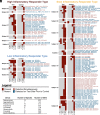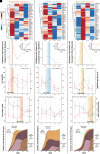Localized microbially induced inflammation influences distant healthy tissues in the human oral cavity
- PMID: 37782795
- PMCID: PMC10576129
- DOI: 10.1073/pnas.2306020120
Localized microbially induced inflammation influences distant healthy tissues in the human oral cavity
Abstract
Variation in human immune response to the same bacterial or viral pathogen is well established in the literature. Variation in immune response to microbial challenge has also been observed within the human oral cavity. Our recent study focused on characterizing observed variations in microbially induced gingival inflammation-resulting in three distinct clinical Inflammatory Responder Types (IRTs): High-IRT, Low-IRT, and Slow-IRT. Here, we applied a high-resolution temporal multiomic analysis during microbially induced inflammation in order to characterize the effects of localized oral inflammation on distant healthy tissues in young healthy adults. Our results highlight a nonlocalized subclinical effect with alterations in proinflammatory host mediators and an ecological shift toward dysbiosis within the subgingival microbiome in an IRT-dependent manner-despite maintained oral hygiene. Our results provide mechanistic insight into how healthy tissues within humans are influenced by distant localized inflammation and may ultimately become susceptible to disease.
Keywords: experimental gingivitis; host response; mucosal inflammation; periodontal disease; subgingival microbiome.
Conflict of interest statement
The authors declare no competing interest.
Figures






References
-
- Loe H., Silness J., Periodontal disease in pregnancy. I. Prevalence and severity. Acta Odontol. Scand. 21, 533–551 (1963). - PubMed
-
- Trombelli L., et al. , Experimental gingivitis: Reproducibility of plaque accumulation and gingival inflammation parameters in selected populations during a repeat trial. J. Clin. Periodontol. 35, 955–960 (2008). - PubMed
-
- Trombelli L., et al. , Modulation of clinical expression of plaque-induced gingivitis. III. Response of "high responders" and "low responders" to therapy. J. Clin. Periodontol. 31, 253–259 (2004). - PubMed
-
- Trombelli L., et al. , Modulation of clinical expression of plaque-induced gingivitis. II. Identification of "high-responder" and "low-responder" subjects. J. Clin. Periodontol. 31, 239–252 (2004). - PubMed
Publication types
MeSH terms
Grants and funding
LinkOut - more resources
Full Text Sources
Medical

